Ijraset Journal For Research in Applied Science and Engineering Technology
- Home / Ijraset
- On This Page
- Abstract
- Introduction
- Conclusion
- References
- Copyright
Braille E-Book Reader
Authors: Senbagavalli G, Rakshita Mayur, Shriraksha Panduranga Gudikoti, Suhas V, Sushmitha M
DOI Link: https://doi.org/10.22214/ijraset.2025.66174
Certificate: View Certificate
Abstract
There are total 37 million blind people across the world. Out of that 15 million are from India. These people are unable to access the documents or electronics media which are not available in Braille scripts. Here we are implementing enhanced Braille system that helps blind people to read text or content. We extracted PDF and it will be converted into text using Python Script. The detected text will be given to Arduino Mega which recognize every character and convert it into Braille code. With the help of solenoid, we are displaying that Braille code on Braille.
Introduction
I. INTRODUCTION
As per World Health Organization (WHO), out of the 6737.5 million of world population, 39.365 million people are blind, 246.024 million people are suffering from low vision, and 285.389 million people are visually impaired.
A Braille Display is a touch sensation device that takes a pdf or normal text (.txt) file from a computer which is converted from PDF that has been recognized and generates Braille dots for the people who have weak eyesight. Several types of actuators are employed by different types of Braille display devices. With the help of plunger movement in the coil, devices like solenoid prints out Braille.
A. Braille System
Louis Braille, a French educator, invented a system of reading and writing for use by the visually impaired, called worldwide as Braille. Braille uses a structure of six dots, or eight dots composed together in a fixed matrix, called a cell. Each and every dot is either raised or flattened, giving 61 possible combinations in six-dot & 256 possible combinations in eight-dot Braille. In six-dot composition, each character is formed in a matrix having three rows and two columns. For text printed on both sides, the grid of the verso text is shifted so that its dots fall in between the recto dots. Braille represents lower number of characters per page. For a page with 25cm of width and 29 cm of length, there are 32 characters per line & 27 lines per page, with a typical dot of 1.8 mm diameter. This paper intends to present a solution, making learning process for a visually impaired person straightforward. All books cannot be obtained in Braille script, and neither can we have audio files for all books.
B. Braille Cells
A matrix with two columns and three rows of dots is arranged for each Braille cell. In any of these six positions the dots can be raised, total number of permutations is 64. Each position is numbered where dots are popped, example: 1 to 3 on Left Hand Side and 4 to 6 on Right Hand Side, from top to bottom.
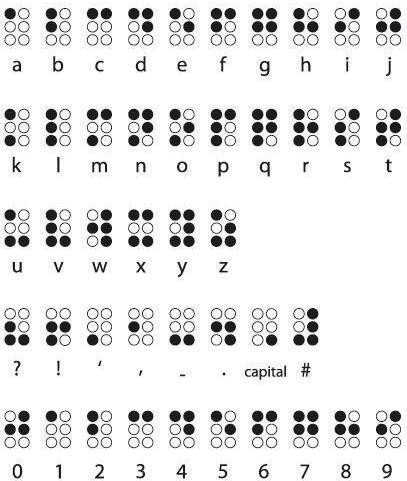
Fig. 1. Braille Alphabet and Numbers
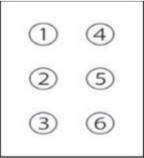
Fig. 2. Braille Cell
II. LITERATURE SURVEY
To identify the many types of visually impaired, several researchers have suggested image processing as well as text approaches. Here, we go over a few of the methods that have been documented in the literature.
Dapeng Chen, Yujie Zhang, Xuhui Hu, Year: 2021,” Development and Evaluation of Refreshable Braille Display and Active Touch-Reading System for Digital Reading of the Visually Impaired “This paper presents the development of a refreshable Braille display that uses an electro-mechanical system to form Braille dots. It integrates an active touch-reading system that aids visually impaired users in reading digital content efficiently. The system combines hardware components for real-time feedback and digital connectivity to enhance accessibility. The traditional way of reading through Braille books is constraining the reading experience of blind or visually impaired (BVI) in the digital age. In order to improve the reading convenience of BVI, this paper proposes a low-cost.
Tasleem Kausar, Sajjad Mazoor, Adeeba Kausar, Yun Lu, Muhammad Wasif, Andan Ashraf year 2021, “Deep Learning Strategy for Braille Character Recognition”.The system captures images of Braille text and converts them into readable digital text. The model is trained on a large dataset to ensure accuracy and versatility. People with vision impairment use Braille language for reading, writing, and communication. This paper presents a deep learning-based system for recognizing Braille characters using convolutional neural networks (CNNs). The system captures images of Braille text and converts them into digital text, aiding visually impaired individuals in reading and communication. Braille characters consist of six dots arranged in three rows and two columns, which are identified by touch. However, memorizing these patterns can be challenging.
Oliver Ozioko, Prakash Karipoth, Marion Hersh, Ravinder Dahiya year 2020,” Wearable Assistive Tactile Communication Interface Based on Integrated Touch Sensors and Actuators Array with Attention-Mechanism Model”. This paper presents a wearable assistive interface for visually impaired users, combining touch sensors and actuators. An attention-mechanism model is employed to optimize touch interaction by filtering out unnecessary stimuli and focusing on important information. The interface is based on finger Braille, which is a simple and efficient tactile communication method used by deafblind people.
Shabnam Mohamed Aslam, Shirina Samreen year 2020 " Gesture Recognition Algorithm for Visually Blind Touch Interaction Optimization”, This paper introduces a gesture recognition algorithm designed to optimize touch interaction for the visually impaired. It uses machine learning techniques to predict and adapt to users' gestures for navigating and reading through digital Braille systems. Touch screen interaction system is highly demanding for new innovations such as visual sensing, virtual key board system on the screen, three dimensional gesture communications methods, and RFID sensing.
Adrian MOISE "Automatic system for conversion text to braille Conversion 2017”. The authors of this paper paper present the development of an automatic system used to convert computer written text to the Braille language. The system uses a microcontroller connected to a special device that can be read by blind persons. For this system, a software based concept to implementing Finite State Machines (FSM) has been developed. Experimental results are shown and discussed. Focuses on the development of an automated solution for translating textual information into Braille, aimed at improving accessibility for visually impaired individuals.
Joshua L. Dela Cruz, Jonaida Angela D. Ebreo, Reniel Allan John P. Inovejas, Year: 2017.” Development of a text to braille interpreter for printed documents through optical image processing This paper presents the development of an optical text to braille converter device for aiding visually impaired individuals to read printed materials. This is a solution for the lag or even failure of translating or printing the braille version of everyday reading materials. The system utilized optical character recognition engine in which an image of the text to be translated into braille is captured. The digitized texts are then transferred electronically in a braille haptic device.
Samuel Dolphin, Maren Dowing, Mia Cirrincione, Adam Samuta, Kevin Leite, Year: 2018” Information Accessibility in the Form of Braille” The study focuses on the accessibility of information through Braille systems, analyzing the transition from physical to digital Braille forms.
It highlights the advancements in tactile Braille displays and how they enhance learning and communication for visually impaired individuals. Braille is often proposed by the uninformed as the optimal solution to providing an alternative to visual information to the visually impaired. The purpose of this article is to highlight the complexity of the braille user population and discuss the importance of understanding the use of braille as a solution for equal access of information.
Fang Wang, Ke Sun, Yi Sun, Heng Yang, Xinxin Li, Year: 2015” Braille Tactile-to-Auditory Conversion System Based on Self-Learning Flexible Tactile Sensor” The paper introduces a Braille tactile-to-auditory conversion system that uses a self-learning flexible tactile sensor to assist visually impaired individuals in reading. The system translates tactile Braille patterns into auditory feedback, addressing challenges of high learning costs and recognition difficulties. A high-density, flexible tactile sensor array with 16 × 16 ultra-small MEMS silicon pressure sensors (256 sensors, 0.65mm pitch) enables full-area scanning of Braille characters. The tactile recognition model incorporates an attention mechanism neural network for accurate Braille pattern learning. Integrated with a Raspberry Pi 4B, the system performs real-time conversion of mechanical stimuli to electrical signals and subsequently to audio signals. Self-developed application software ensures seamless interaction between users and the device.
Hyun-Cheol Cho, Byeong-Sang Kim, Jung-Jun Park, Jae-Bok Song, Publication: International Joint Conference, Year: 2006” Development of a Braille Display using Piezoelectric Linear Motors” The refreshable Braille displays for visually impaired people should be portable and capable of real-time display. To this end, the actuators used to move Braille dots should be small and lightweight. So far various actuators such as solenoids, piezoelectric materials, electroactive polymers have been suggested, but these actuators have not been very successful for various reasons. In this research, piezoelectric linear motors were adopted for this purpose. These actuators can provide the response time fast enough to offer real-time display, and are small and lightweight enough to be employed for a portable device.
Vassilios Papadimitriou and Vassilios Argyropoulos, Publication: British Journal of Visual Impairment, Year: 1987” Tracing the effectiveness of braille reading patters in individuals with blindness: Handedness and error analysis” The main objective of the present study was to investigate the potential effects of handedness on braille reading patterns during braille text reading. Thirty-two Greek students (from Grades 3 to 12) with visual impairments, who used systematically the braille code as reading medium, participated in this study. Handedness was assessed through a modified version of the Edinburgh Handedness Inventory, while their reading level was estimated via a standardized test.
Sangeeta Kumari, Akshay Akole, Pallavi Angnani, Yash Bhamare, Zaid Naikwadi, “Enhanced Braille Display” International Conference for Emerging Technology, 2020. This paper presents an Enhanced Braille Display system designed to assist visually impaired individuals in accessing digital and printed text. With 37 million blind individuals globally, including 15 million in India, the lack of accessible Braille documents and electronic media is a significant challenge. This system offers a cost-effective, portable, and efficient solution to bridge the accessibility gap. The system begins by capturing images using a camera, processing them with image processing techniques, and converting them into text using Optical Character Recognition (OCR). The detected text is sent to a Raspberry Pi, which translates it into Braille code. Using solenoids, the Braille code is displayed on a tactile interface for users to read.
III. METHODOLOGY
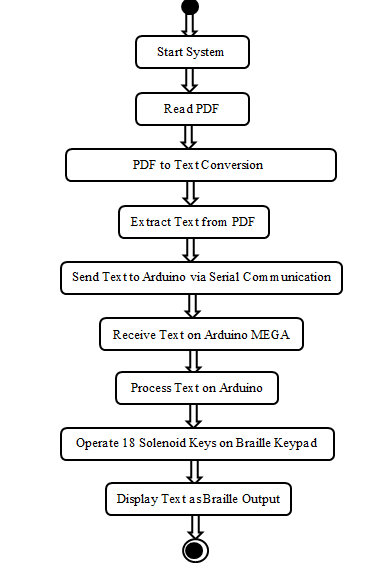
Fig. 3. Flow Chart
This flowchart outlines the methodology for a project involving converting PDF text to Braille output using Arduino. Here's a brief explanation of each step:
- Start System: The system is powered on or initialized.
- Read PDF: The system reads a PDF document as the input source.
- PDF to Text Conversion: The content of the PDF is converted into text format.
- Extract Text from PDF: The relevant text is extracted from the PDF for processing.
- Send Text to Arduino via Serial Communication: The extracted text is transmitted to an Arduino board using serial communication.
- Receive Text on Arduino MEGA: The Arduino MEGA board receives the transmitted text data.
- Process Text on Arduino: The Arduino processes the received text to prepare it for Braille output.
- Operate 18 Solenoid Keys on Braille Keypad: The Arduino controls solenoid keys that correspond to Braille characters.
- Display Text as Braille Output: The processed text is displayed on a Braille keypad as tactile Braille output.
BLOCK DIAGRAM
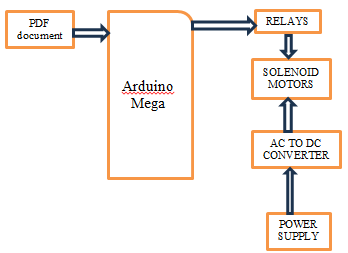
This diagram illustrates a system that integrates an Arduino Mega microcontroller to control solenoid motors using relays.
- PDF Document (Input): This represents the user input in the form of a PDF document. The system might process data from the document, such as commands, configurations, or sequences, that will be sent to the Arduino Mega.
- Arduino Mega: The Arduino Mega serves as the central controller of the system. It processes input data from the PDF document, interprets it, and sends control signals to the relays. It likely uses a programmed logic to determine how and when to activate the relays based on the input data.
- Relays: Relays act as switches to control the power delivery to the solenoid motors. The Arduino sends signals to the relays to open or close the circuits, thereby activating or deactivating the solenoids.
- Solenoid Motors: These are electromechanical devices that perform physical actions when powered. The relays control the activation of these motors, which might be used for various applications like locking mechanisms, pushing, pulling, or other linear motions.
- AC to DC Converter: This module converts AC power from the power supply into the required DC power needed for the solenoid motors and possibly other components in the system.
- Power Supply: This provides the primary source of electrical energy for the entire system. It supplies AC power that is converted into DC by the AC to DC converter.
IV. HARDWARE REQUIREMENTS
A. Arduino MEGA
The Arduino Mega 2560 is a microcontroller board based on the ATmega2560. It has 54 digital input/output pins (of which 15 can be used as PWM outputs), 16 analog inputs, 4 UARTs (hardware serial ports), a 16 MHz crystal oscillator, a USB connection, a power jack, an ICSP header, and a reset button.
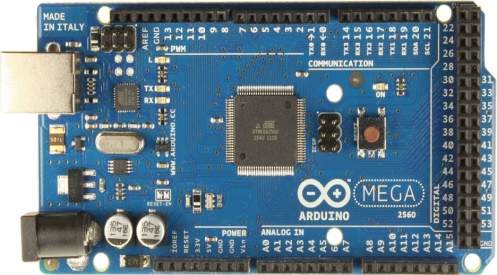
Fig. 4. Arduino MEGA 2560
B. Relays (ULN2003AN)
TheULN2003 is high-voltage high-current Darlington transistor arrays each containing seven open collector common emitter pairs. Each pair is rated at 500mA. Suppression diodes are included for inductive load driving, the inputs and outputs are pinned in opposition to simplify board layout.
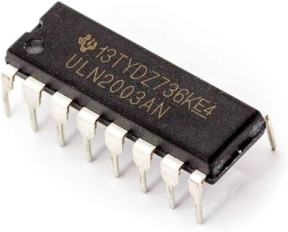
Fig. 5. ULN2003AN
C. Solenoid Motors
A solenoid is made up of a coil of wire, a movable core, and a housing. When an electrical current passes through the coil, it creates a magnetic field that pulls the core in.
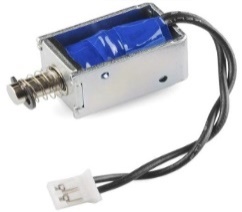
Fig.6. Solenoid motor
D. AC to DC Converter
AC to DC Converters are one of the most important elements in power electronics. This is because there are a lot of real-life applications that are based on these conversions. The electrical circuits that transform alternating current (AC) input into direct current (DC) output are known as AC-DC converters. They are used in power electronic applications where the power input a 50 Hz or 60 Hz sine-wave AC voltage that requires power conversion for a DC output. The process of conversion of AC current to dc current is known as rectification. The rectifier converts the AC supply into the DC supply at the load end connection. Similarly, transformers are normally used to adjust the AC source to reduce the voltage level to have a better operation range for DC supply.
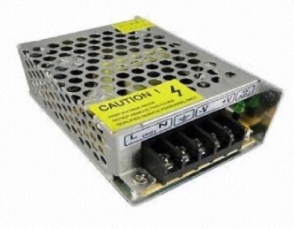
Fig. 7. AC to DC Converter
V. RESULTS
When you click the "Open PDF" button, a file dialog will open to select a PDF file.
After selecting the PDF, the program extracts the text, converts it to Braille, and displays the Braille characters in a text box.
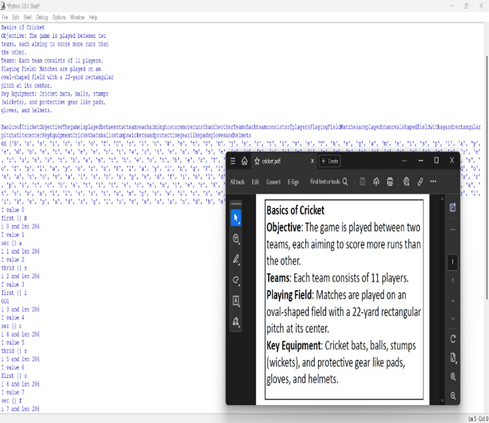
Fig. 8. Result Window
The image shows a demonstration of a Braille e-book reader project, where a PDF file containing text is processed to convert its content into a Braille format. Below is a detailed explanation for the results:
- Input Source: The input text is sourced from a PDF file, as shown in the screenshot. The content discusses the text with structured headings and paragraphs.
- Text Extraction: Using a Python script, the text is extracted from the PDF file. This is visible in the output as a single string with no formatting or spaces.
- Conversion to Braille: The extracted text is parsed character by character, where each character is converted into its corresponding Braille representation. The log in the Python shell illustrates intermediate steps of this conversion: i value indicates the current index of thc character in the input string. first, sec, and third logs represent the breakdown of characters into Braille cells for tactile feedback.
- Output Representation: The Braille text is represented in a format suitable for physical or electronic Braille displays. Each character's Braille equivalent is mapped to create a seamless reading experience for visually impaired users.
- Validation: The visual comparison between the input PDF and the processed output confirms accurate text extraction and Braille conversion. This validates the system's ability to handle structured and unstructured text.
Following is an example:
- Consider a page with the word “Hello”.
- An PDF of this page is taken.
- The text in this PDF is then recognized by the Python Script.
- The word “Hello” is broken down into individual characters i.e. “H”, “e”, “l”, “l”, “o".
- Each individual character is then mapped to a braille characters through a lookup table. And represents control signal for solenoid.
- Piston of every individual solenoid is either raised or not, depending on signal. This is similar to Braille representation where dots are raised. For the word “Hello”, we have
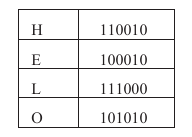
Therefore, for character H, 1st, 2nd, and 5th solenoid will be raised and remaining will not be raised.
- Hence all characters are displayed sequentially. So, for the word “Hello”, the sequence will be H, e, l, l, o.
- Simultaneously after step No 4, the recognized word is forwarded to cloud for storage.
This example demonstrates the workflow for the Braille system in turn giving insight about it. The system displays the result of each character for enough time to read for a person.
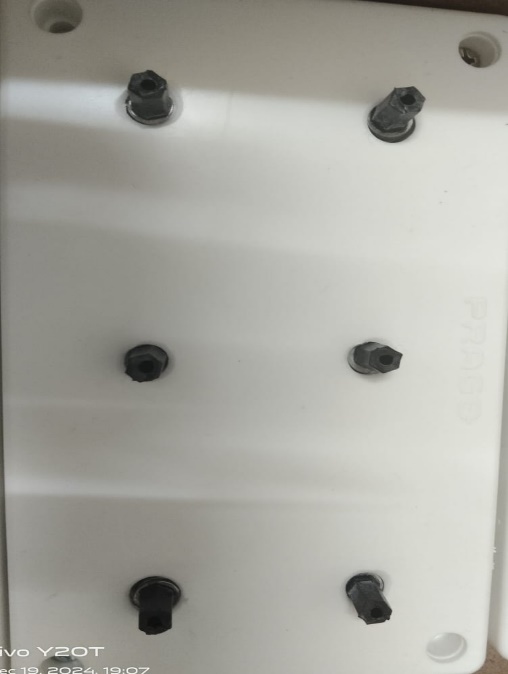
Fig. 9. An instance of all solenoids in action.
Solenoid motors are used to create a tactile representation of Braille characters. Each solenoid acts as a pin that moves up or down to form the raised dots of a Braille cell.
Solenoid motors enable a refreshable Braille display. This means that as the user reads, the solenoids dynamically update the pattern of raised and lowered dots to display new characters or text lines, similar to scrolling on a screen.
In this project, the system would process text input (e.g., a PDF document) to identify characters. The Arduino Mega processes this input and determines the corresponding Braille pattern for each character.
The solenoids provide physical feedback by creating the raised dot patterns that visually impaired users can feel and read with their fingertips.

Fig. 10. Actual Implementation
The Braille e-book reader hardware setup consists of an array of electromechanical actuators configured to represent Braille characters tactilely. The system processes digital text, converting each character into its corresponding Braille code. The input text is fed to a microcontroller (Arduino Mega), which controls the activation of the actuators. Each actuator corresponds to one dot of the 6-dot Braille cell, and their configuration changes dynamically to display sequential characters from the input text. A power supply unit ensures consistent operation, while the control circuit interfaces between the microcontroller and the actuators. This system allows visually impaired users to perceive text through touch, bridging the accessibility gap for digital reading. Wires connect all components, ensuring communication between the Arduino, driver circuits, and solenoids.
The Arduino Mega processes the text and determines which solenoids need to be activated for each Braille character. It sends control signals to the relay/driver circuits. The relay/driver circuits amplify the signals and power the respective solenoids to form raised Braille dots.
Conclusion
Thus, a new system is proposed due to the shortcomings of existing systems. The PDF is converted to text using Python Script and mapped to the Braille alphabet. These alphabets are then physically represented using solenoids. This system is small in size, and portable.
References
[1] Dapeng Chen, Yujie Zhang, Xuhui Hu, “Development and Evaluation of Refreshable Braille Display and Active Touch-Reading System for Digital Reading of the Visually Impaired”, 2021 [2] Tasleem Kausar, Sajjad Mazoor, Adeeba Kausar, Yun Lu, Muhammad Wasif, Andan Ashraf, “ Deep Learning Strategy for Braille Character Recognition”, 2021.. [3] Oliver Ozioko, Prakash Karipoth, Marion Hersh, Ravinder Dahiya, “Wearable Assistive Tactile Communication Interface Based on Integrated Touch Sensors and Actuators Array with Attention-Mechanism Model”, 2020. [4] Sangeeta Kumari, Akshay Akole, Pallavi Angnani, Yash Bhamare, Zaid Naikwadi, “Enhanced Braille Display”, International Conference for Emerging Technology, 2020 [5] Shabnam Mohamed Aslam, Shirina Samreen, “Gesture Recognition Algorithm for Visually Blind Touch Interaction Optimization”, 2019. [6] Adrian Moise et.al, “Automatic system for text to Braille conversion”, 9th International Conference on Electronics, Computers an Artificial Intelligence (ECAI). DOI: 10.1109/ECAI.2017.8166391, 2017. [7] Joshua L. Dela Cruz et.al, “Development of a text to braille interpreter for printed documents through optical image processing”, IEEE 9th International Conference on Humanoid, Nanotechnology, Information Technology, Communication and Control, Environment and Management (HNICEM). DOI: 10.1109/HNICEM.2017.8269523, 2017 [8] Samuel Dolphin, Maren Dowing, Mia Cirrincione, Adam Samuta, Kevin Leite , “Information Accessibility in the Form of Braille”, 2016 [9] Fang Wang, Ke Sun, Yi Sun, Heng Yang, Xinxin Li, “ Braille Tactile-to-Auditory Conversion System Based on Self-Learning Flexible Tactile Sensor”, 2015 [10] Hyun-Cheol Cho et.al, “Development of a Braille Display using Piezr”, SICE-ICASE International Joint Conference: Bexco, Busan, Korea: October 2006 [11] Vassilios Papadimitriou and Vassilios Argyropoulos, “Tracing the effectiveness of braille reading patterns in individuals with blindness: Handedness and error analysis”, British Journal of VisualImpairment,1987.
Copyright
Copyright © 2025 Senbagavalli G, Rakshita Mayur, Shriraksha Panduranga Gudikoti, Suhas V, Sushmitha M. This is an open access article distributed under the Creative Commons Attribution License, which permits unrestricted use, distribution, and reproduction in any medium, provided the original work is properly cited.

Download Paper
Paper Id : IJRASET66174
Publish Date : 2024-12-29
ISSN : 2321-9653
Publisher Name : IJRASET
DOI Link : Click Here
 Submit Paper Online
Submit Paper Online

